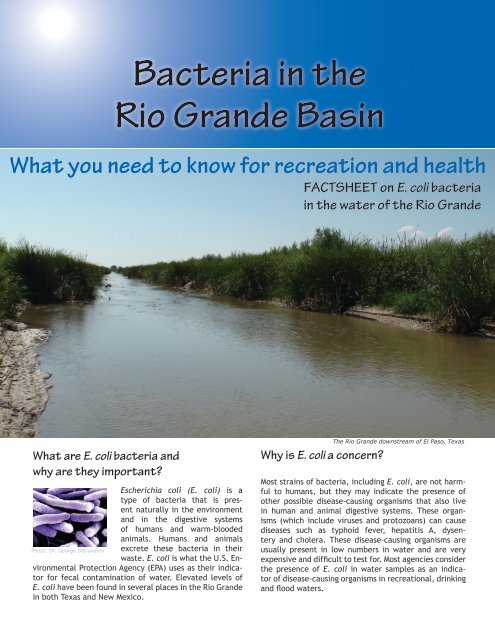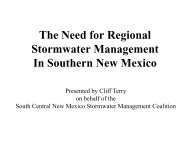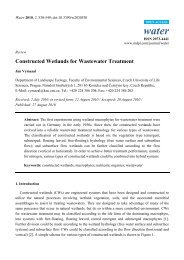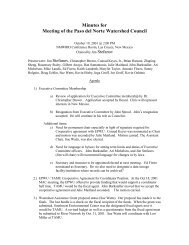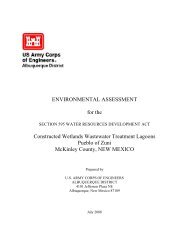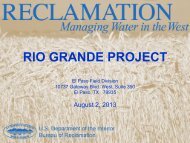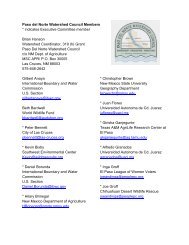Bacteria in the Rio Grande Basin
Bacteria in the Rio Grande Basin
Bacteria in the Rio Grande Basin
You also want an ePaper? Increase the reach of your titles
YUMPU automatically turns print PDFs into web optimized ePapers that Google loves.
What you need to know for recreation and health<br />
FACTSHEET on E. coli bacteria<br />
<strong>in</strong> <strong>the</strong> water of <strong>the</strong> <strong>Rio</strong> <strong>Grande</strong><br />
What are E. coli bacteria and<br />
why are <strong>the</strong>y important?<br />
Escherichia coli (E. coli) is a<br />
type of bacteria that is present<br />
naturally <strong>in</strong> <strong>the</strong> environment<br />
and <strong>in</strong> <strong>the</strong> digestive systems<br />
of humans and warm-blooded<br />
animals. Humans and animals<br />
Photo: Dr. George DiGiovanni excrete <strong>the</strong>se bacteria <strong>in</strong> <strong>the</strong>ir<br />
waste. E. coli is what <strong>the</strong> U.S. Environmental<br />
Protection Agency (EPA) uses as <strong>the</strong>ir <strong>in</strong>dicator<br />
for fecal contam<strong>in</strong>ation of water. Elevated levels of<br />
E. coli have been found <strong>in</strong> several places <strong>in</strong> <strong>the</strong> <strong>Rio</strong> <strong>Grande</strong><br />
<strong>in</strong> both Texas and New Mexico.<br />
Why is E. coli a concern?<br />
The <strong>Rio</strong> <strong>Grande</strong> downstream of El Paso, Texas<br />
Most stra<strong>in</strong>s of bacteria, <strong>in</strong>clud<strong>in</strong>g E. coli, are not harmful<br />
to humans, but <strong>the</strong>y may <strong>in</strong>dicate <strong>the</strong> presence of<br />
o<strong>the</strong>r possible disease-caus<strong>in</strong>g organisms that also live<br />
<strong>in</strong> human and animal digestive systems. These organisms<br />
(which <strong>in</strong>clude viruses and protozoans) can cause<br />
diseases such as typhoid fever, hepatitis A, dysentery<br />
and cholera. These disease-caus<strong>in</strong>g organisms are<br />
usually present <strong>in</strong> low numbers <strong>in</strong> water and are very<br />
expensive and difficult to test for. Most agencies consider<br />
<strong>the</strong> presence of E. coli <strong>in</strong> water samples as an <strong>in</strong>dicator<br />
of disease-caus<strong>in</strong>g organisms <strong>in</strong> recreational, dr<strong>in</strong>k<strong>in</strong>g<br />
and flood waters.
High bacteria is one of <strong>the</strong> biggest water quality issues of <strong>the</strong> <strong>Rio</strong> <strong>Grande</strong>...<br />
How do E. coli bacteria get <strong>in</strong>to <strong>the</strong> <strong>Rio</strong> <strong>Grande</strong>?<br />
Contam<strong>in</strong>ation of water with human or animal waste, known as fecal contam<strong>in</strong>ation,<br />
can happen <strong>in</strong> many different ways. Sewer overflows, which occur dur<strong>in</strong>g<br />
ra<strong>in</strong>storms when pipes carry both ra<strong>in</strong>water and sewage, may contribute to<br />
contam<strong>in</strong>ation <strong>in</strong> <strong>the</strong> river. Leak<strong>in</strong>g septic tanks, sewer malfunctions, feedlots,<br />
animal waste (both domestic and wildlife), and landfill leakage are all common<br />
sources of water contam<strong>in</strong>ation. Ra<strong>in</strong> events can wash all of this <strong>in</strong>to <strong>the</strong> <strong>Rio</strong><br />
<strong>Grande</strong> and o<strong>the</strong>r nearby waterways without <strong>the</strong> water be<strong>in</strong>g treated first.<br />
What are <strong>the</strong> health risks from contact with bacteria?<br />
Health risks associated with contact with <strong>the</strong> water <strong>in</strong> <strong>the</strong> <strong>Rio</strong> <strong>Grande</strong> are m<strong>in</strong>imal<br />
because E. coli is usually not harmful. However, water with high levels of<br />
E. coli may conta<strong>in</strong> o<strong>the</strong>r disease-caus<strong>in</strong>g organisms, and <strong>in</strong>gestion of contam<strong>in</strong>ated<br />
water from any area should be avoided when swimm<strong>in</strong>g. Symptoms from<br />
<strong>in</strong>gest<strong>in</strong>g contam<strong>in</strong>ated water could <strong>in</strong>clude stomach and bowel discomfort,<br />
which can cause problems such as diarrhea, vomit<strong>in</strong>g, and abdom<strong>in</strong>al cramps.<br />
Symptoms, while uncomfortable, are rarely life-threaten<strong>in</strong>g and usually require<br />
very little, if any, medical treatment. Most gastro<strong>in</strong>tenst<strong>in</strong>al illnesses are allowed<br />
to clear up without treatment <strong>in</strong> just a few days. Contact of E. coli<br />
with sk<strong>in</strong> does not usually result <strong>in</strong> any symptoms (no rash, for example), unless<br />
<strong>the</strong>re are open wounds. O<strong>the</strong>r illnesses commonly seen when swimm<strong>in</strong>g <strong>in</strong><br />
contam<strong>in</strong>ated water <strong>in</strong>clude <strong>in</strong>fections of <strong>the</strong> throat, eye, nose and ears. If you<br />
come <strong>in</strong>to contact with contam<strong>in</strong>ated water, make sure to wash <strong>the</strong> areas well<br />
with warm soap and water, particularly your hands, and any o<strong>the</strong>r item (balls,<br />
Frisbees) that came <strong>in</strong>to contact with <strong>the</strong> water. In <strong>the</strong> event of <strong>in</strong>gestion,<br />
make sure to report any illness or symptoms to your doctor.<br />
How is E. coli monitored <strong>in</strong> <strong>the</strong> <strong>Rio</strong> <strong>Grande</strong>?<br />
In our dr<strong>in</strong>k<strong>in</strong>g water?<br />
Rout<strong>in</strong>e water samples are collected by different agencies and sent to a laboratory<br />
for analysis. These agencies <strong>in</strong>clude <strong>the</strong> U.S. Section of <strong>the</strong> International<br />
Boundary and Water Commission (USIBWC), <strong>the</strong> Texas Commission on Environmental<br />
Quality (TCEQ), <strong>the</strong> U.S. Geological Survey (USGS), and o<strong>the</strong>rs. The<br />
laboratory will test <strong>the</strong> water samples for many different chemicals and organisms,<br />
<strong>in</strong>clud<strong>in</strong>g bacteria, and send <strong>the</strong> results to <strong>the</strong> agencies so that <strong>the</strong>y can<br />
determ<strong>in</strong>e if any action is necessary. Treatment plants that provide dr<strong>in</strong>k<strong>in</strong>g<br />
water to large populations are required by law to test <strong>the</strong>ir water systems<br />
for <strong>the</strong> presence of bacteria. The plants must test a specific number of times<br />
monthly to ensure <strong>the</strong> safety of <strong>the</strong>ir water supply.<br />
What is considered a “safe” level of bacteria?<br />
Each <strong>in</strong>dividual is responsible for decid<strong>in</strong>g what k<strong>in</strong>d of risk <strong>the</strong>y wish to take<br />
when swimm<strong>in</strong>g <strong>in</strong> lakes, rivers, and o<strong>the</strong>r water bodies. Each state has regulations<br />
on <strong>the</strong> amount of bacteria that is considered safe for waters where <strong>the</strong>re<br />
is contact recreation, which <strong>in</strong>cludes swimm<strong>in</strong>g. In <strong>the</strong> states of Texas and New<br />
Mexico, E. coli levels <strong>in</strong> many parts of <strong>the</strong> <strong>Rio</strong> <strong>Grande</strong> are above <strong>the</strong> state regulated<br />
levels, and <strong>in</strong> <strong>the</strong>se areas <strong>the</strong> <strong>Rio</strong> <strong>Grande</strong> is impaired for bacteria. This does<br />
not mean that bacteria read<strong>in</strong>gs above this <strong>in</strong>dicate that an <strong>in</strong>dividual will get<br />
sick; it simply means that <strong>the</strong> risk for becom<strong>in</strong>g ill is greater. The same is said<br />
about bacteria levels lower than <strong>the</strong>se numbers--lower numbers do not mean<br />
that <strong>the</strong> water is completely safe ei<strong>the</strong>r.<br />
Sources: Indiana Department of Environmental Management, E. coli Fact Sheet, www.idem.IN.gov;<br />
U.S. Environmental Protection Agency, Fecal <strong>Bacteria</strong>, www.epa.gov/volunteer/stream/vms511.html;<br />
DiGiovanni, George. Drought May Concentrate Pathogens <strong>in</strong> Surface Water. Southwest Hydrology, Vol 3, Number 4, Nov/Dec 2004;<br />
Public Health Solutions www.phsneb.org/alpha_search/e.coli.water.html; and EPA’s Pollution Toolbox http://www.epa.gov/nps/toolbox.
Can I swim <strong>in</strong> <strong>the</strong> water? What about canoe<strong>in</strong>g or<br />
kayak<strong>in</strong>g? Can my dog dr<strong>in</strong>k <strong>the</strong> water?<br />
As required by <strong>the</strong> Clean Water Act, each state is responsible for compil<strong>in</strong>g a<br />
list of water bodies with contam<strong>in</strong>ation levels higher than surface water quality<br />
standards. If a water body is impaired for contact recreation, <strong>the</strong> risk of becom<strong>in</strong>g<br />
ill dur<strong>in</strong>g recreational activities such as swimm<strong>in</strong>g, canoe<strong>in</strong>g, or kayak<strong>in</strong>g<br />
<strong>in</strong>creases. Pets and people should be discouraged from dr<strong>in</strong>k<strong>in</strong>g <strong>the</strong> water <strong>in</strong> <strong>the</strong><br />
<strong>Rio</strong> <strong>Grande</strong>, and from any water body that is not properly treated. You should<br />
be aware before swimm<strong>in</strong>g <strong>in</strong> <strong>the</strong> water whe<strong>the</strong>r <strong>the</strong> water body is impaired.<br />
You should also avoid swimm<strong>in</strong>g after a big ra<strong>in</strong> event, especially <strong>in</strong> urban areas,<br />
because bacteria levels may be higher due to runoff <strong>in</strong>to <strong>the</strong> waterways. In <strong>the</strong><br />
West Texas area, dur<strong>in</strong>g non-irrigation cycles or drought periods, water levels are<br />
lower. Water bodies dur<strong>in</strong>g <strong>the</strong>se conditions may conta<strong>in</strong> higher levels of diseasecaus<strong>in</strong>g<br />
organisms than normal, and <strong>the</strong> chances of becom<strong>in</strong>g ill <strong>in</strong>crease. This<br />
is because <strong>the</strong> water does not flow regularly, allow<strong>in</strong>g bacteria and o<strong>the</strong>r pathogens<br />
to accumulate more readily than if you had a large amount of flow<strong>in</strong>g water.<br />
Some of our dr<strong>in</strong>k<strong>in</strong>g water comes from <strong>the</strong> river--What<br />
is done to protect me from E. coli and o<strong>the</strong>r bacteria?<br />
The water that comes out of <strong>the</strong> faucets <strong>in</strong> your home is treated by local water<br />
treatment plants and is safe to dr<strong>in</strong>k. Treatment plants and o<strong>the</strong>r facilities use<br />
many different types of methods to sanitize dr<strong>in</strong>k<strong>in</strong>g water. The most commonly<br />
used methods are chlor<strong>in</strong>e and ultraviolet light, but o<strong>the</strong>r methods may also be<br />
utilized.<br />
What is be<strong>in</strong>g done to improve water quality <strong>in</strong> <strong>the</strong><br />
affected water bodies?<br />
Various entities are work<strong>in</strong>g on projects to address bacteria <strong>in</strong> surface water. The<br />
Paso del Norte Watershed Council and <strong>the</strong> New Mexico Environment Department<br />
are work<strong>in</strong>g on a watershed plan for <strong>the</strong> sou<strong>the</strong>rn New Mexico portion of <strong>the</strong> <strong>Rio</strong><br />
<strong>Grande</strong>. The USIBWC Texas Clean Rivers Program conducts rout<strong>in</strong>e monitor<strong>in</strong>g as<br />
well as <strong>in</strong>tensive monitor<strong>in</strong>g to understand bacteria contam<strong>in</strong>ation <strong>in</strong> <strong>the</strong> Texas<br />
portion of <strong>the</strong> <strong>Rio</strong> <strong>Grande</strong>. These entities are also conduct<strong>in</strong>g outreach to make<br />
<strong>the</strong> public aware of <strong>the</strong> issues. International entities such as <strong>the</strong> Border Environmental<br />
Cooperation Commission assist communities with money for <strong>in</strong>frastructure<br />
projects for sewer systems. See websites on back for more <strong>in</strong>formation.<br />
What can I do to help?<br />
Here are some ways you can help protect <strong>the</strong> <strong>Rio</strong> <strong>Grande</strong> from bacteria:<br />
• Pick up your dog’s waste when you walk your dog;<br />
• Ensure your septic tanks are pumped and <strong>in</strong>spected regularly;<br />
• Ranchers can manage <strong>the</strong>ir herds so <strong>the</strong>y don’t graze along streams;<br />
• Participate <strong>in</strong> community cleanups for highways and rivers;<br />
• Visit www.<strong>in</strong>yourwater.org for more tips on what you can do;<br />
Photo: City of N. Las Vegas, EPA NPS Toolkit<br />
• Get <strong>in</strong>volved <strong>in</strong> your local watershed group (see websites on back).
Where can I f<strong>in</strong>d out if <strong>the</strong> <strong>Rio</strong> <strong>Grande</strong> near my town is<br />
contam<strong>in</strong>ated with bacteria?<br />
Water quality and environmental <strong>in</strong>formation is available us<strong>in</strong>g EPA’s <strong>in</strong>teractive onl<strong>in</strong>e<br />
tool, <strong>the</strong> EnviroMapper for Water, at http://www.epa.gov/waters/enviromapper/.<br />
Texas impaired water bodies are listed at http://www.texaswaterdata.org under “Clean<br />
Water Act (CWA) Sections 305(b) and 303(d) Integrated Report.” You can also f<strong>in</strong>d <strong>in</strong>formation<br />
and data about <strong>the</strong> <strong>Rio</strong> <strong>Grande</strong> Bas<strong>in</strong> at <strong>the</strong> USIBWC Texas Clean Rivers Program<br />
website, http://www.ibwc.gov/CRP/Index.htm.<br />
New Mexico impaired water bodies are listed at:<br />
http://www.nmenv.state.nm.us/SWQB/ under “303d-305b List Report.”<br />
Where can I f<strong>in</strong>d more <strong>in</strong>formation?<br />
U.S.Environmental Protection Agency (EPA) Water Science http://www.epa.gov/waterscience/<br />
EPA Adopt Your Watershed (local watershed groups and more) http://www.epa.gov/owow_keep/adopt/<br />
New Mexico Environment Department http://www.nmenv.state.nm.us/<br />
Texas Commission on Environmental Quality Surface Water Quality Monitor<strong>in</strong>g http://texaswaterdata.org<br />
Paso del Norte Watershed Council http://www.pdnwc.org/<br />
Texas Clean Rivers Program for <strong>the</strong> <strong>Rio</strong> <strong>Grande</strong> Bas<strong>in</strong> http://www.ibwc.gov/CRP/<strong>in</strong>dex.htm<br />
Last Revision December 2010<br />
This factsheet is a jo<strong>in</strong>t project between <strong>the</strong> International Boundary and Water Commission’s Texas Clean Rivers Program (funded through <strong>the</strong> Texas Commission on Environmental<br />
Quality (TCEQ)), and <strong>the</strong> Paso del Norte Watershed Council’s 319(h) program (funded through <strong>the</strong> New Mexico Environment Department’s Surface Water Quality Bureau).<br />
The preparation of this report was f<strong>in</strong>anced through grants from and <strong>in</strong> cooperation with <strong>the</strong> TCEQ. Photo Credits: USIBWC, unless o<strong>the</strong>rwise noted.


